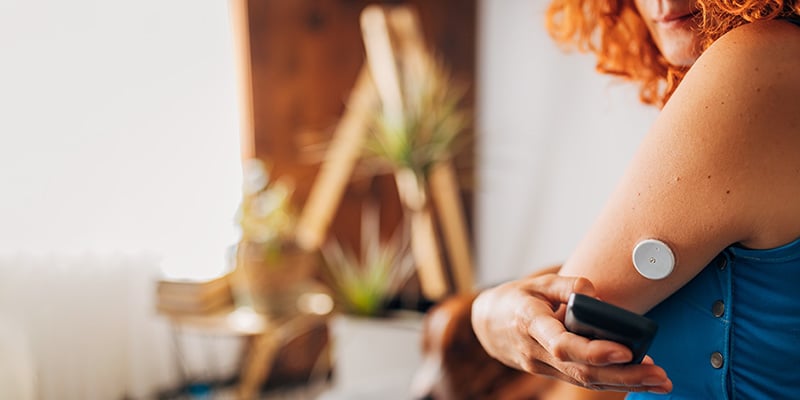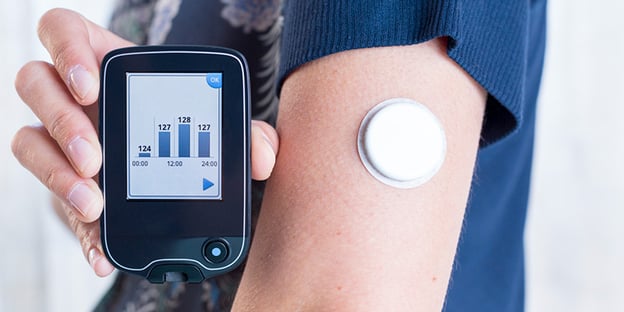Continuous glucose monitors are game changers for those with diabetes. Instead of pricking your fingers to test your blood glucose several times a day, continuous glucose monitors (CGMs) do the hard work for you, painlessly reading your glucose 24/7 so you can make better choices, prevent hypoglycemic and hyperglycemic events, and live a full, healthy life.
It seems like the perfect solution. But not everyone uses it. Adoption rates hover at around 17% for some populations of people with diabetes. Why? Because several hurdles are stopping people from trying these life-changing devices. If you’re in that boat, don’t worry. We’ll unpack some of the mental and physical barriers stopping people from trying CGMs and explain why you don’t need to worry about them.
Body Attachment
Some people have concerns about something being attached to their bodies. Maybe the thought of something under their skin is slightly unnerving, or maybe they just don’t want everyone to know about their medical conditions. Perhaps they’re terrified of needles.
But a CGM, while worn just under the skin, is painless and discreet. The very small needle retracts into the device and is worn just under the skin. CGM devices get smaller all the time and are easy to insert. Most people don’t even feel them. They’re usually worn on the back of the arm but can also be worn in other areas under the guidance of your care team. People usually choose to wear them somewhere that can be easily covered by clothing and won’t get in the way of their daily tasks.
And without being attached to your body, a CGM can’t give you a window into what your body is doing at all times so you can adjust your food, exercise, and stress. You can’t give valuable insight to your care team so they can adjust your insulin. You can’t take control of your health and feel your best. That is, unless you’re willing to prick your fingers multiple times a day. And if you’re worried about something on your body or scared of needles, frequent needle pricks don’t feel like a great alternative.
And at TMS, we know that attaching something to your body can be hit or miss. So we send an extra sensor with your first order so you don’t have to panic if insertion doesn’t go great the first time you try it.
Skin Irritation
While wearing a CGM on your body won’t make you stand out and the tiny needles aren’t a reason to worry, wearing anything on your body for extended periods of time can cause skin irritation. These can range from minor allergic reactions to scars and infections.
Luckily, it’s easy to prevent most of these skin issues. Here are some tips:
- Wash your hands frequently.
- Use an alcohol pad to clean the insertion area before applying your CGM.
- Ensure the insertion area is clean and dry before inserting your CGM.
- Avoid lotions and oils in and around the area where you insert your CGM.
- Don’t always insert your CGM in the exact same location. Instead, vary injection sites every two weeks.
- Choose a flat area to insert your CGM, like the back of your arm.
- Talk to your care team about any recurrent infections or skin irritation.
Fear of Standing Out
This is a big one for children and teens. At that age, no one wants to be seen as different. Children want to be able to do the same things and eat the same foods as their friends, without wearing a device everyone can see.
What’s great about CGMs is that they actually allow that freedom instead of standing in the way of it. Instead of stopping to test several times a day, a CGM lets kids and teens go about their day while it reads their blood glucose levels for them. That lets them make informed choices about food and behavior, so they can have that slice of pizza at the classroom pizza party without feeling left out. And because CGMs are so small and discreet, they won’t bring unwanted attention to themselves the way excusing yourself to test with finger strips would.
Alarm Fatigue
Another fear around CGMs is alarm fatigue. As your blood sugar levels dip or rise, your CGM will alert you. And when you’re new to the device, that can happen frequently as you learn to use the feedback you’re getting to make small changes to your diet and behavior. When alarms constantly go off, some people with diabetes tend to ignore them — a condition called alarm fatigue — and that can lead to hypoglycemia when you don’t act to stop blood sugar dips before they become dangerous.
But there are simple tactics to overcome alarm fatigue. First, you can have your care team adjust your CGM alerts so they don’t go off as often. If your blood glucose usually runs a little high, your team can set the alarms to go off when it’s higher than average, so they won’t interrupt you as often. Severe low alerts, however, can’t be changed or silenced to prevent dangerous hypoglycemic events. Second, you can have your alerts vibrate on your phone instead of making noise. This is also a great trick for those concerned about feeling different or standing out in the crowd. Everyone is always getting text messages on their phones. When your CGM notifies you in the same way a silenced phone does, no one will ever suspect it’s anything different.
Insurance Hurdles
Another factor that stops people from trying a CGM is the cost. Starting out-of-pocket expenses for the device can run up to $1,000, but most insurances cover part or all of those costs.
The problem is that navigating the insurance systems to get them to cover a CGM can be tricky. In fact, according to the National Institute of Health, cost and insurance hurdles together are the top two factors stopping people from trying a CGM.
Luckily, you’ve got a great solution. Total Medical Supply specializes in navigating insurance providers and their requirements for you, so you don’t have to. Here’s how to advocate for a CGM to help manage your diabetes. First, use our handy guide to determine which kind of CGM Is best for your lifestyle, then follow these steps:
- Print the guide or save it to your phone.
- Take the guide to your next doctor’s appointment.
- Discuss the CGM that will work best for your unique needs.
- Ask your doctor for a prescription.
It’s that easy!
A CGM system can be life-changing for patients with diabetes because it’s an easier, more comprehensive, and more convenient way to manage your diabetes and improve your quality of life.
Find out if a CGM is right for you!








